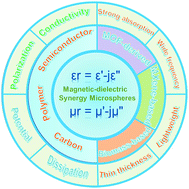Recent progress of microwave absorption microspheres by magnetic–dielectric synergy
Abstract
Designing and developing high-performance microwave absorption (MA) materials for electromagnetic protection and radar detection have received widespread attention. Recently, magnetic–dielectric MA materials have become a research hotspot due to their unique complementary functions and synergy loss mechanism. Herein, we review important research progress of excellent MA systems combining strong magnetic components and dielectric substrates. The functional materials involve magnetic materials, carbon components, semiconductors, polymer and so on. For a comprehensive analysis, current development and challenges are firstly introduced in the background. Modern requirements for microwave energy conversion are elaborated in the following part. To highlight the key points, more attention has been paid to the magnetic–dielectric synergy microsphere: (i) core/yolk–shell structure, (ii) multi-component assembly and (iii) MOF-derived synergy composites. Meanwhile, classical and typical high-performance MA composites with a multi-loss mechanism are also mentioned in this review paper. Finally, the design principles, electromagnetic synergy, future mechanism exploration and device application are presented, which provides guidance for understanding MA materials.

- This article is part of the themed collection: Recent Review Articles


 Please wait while we load your content...
Please wait while we load your content...